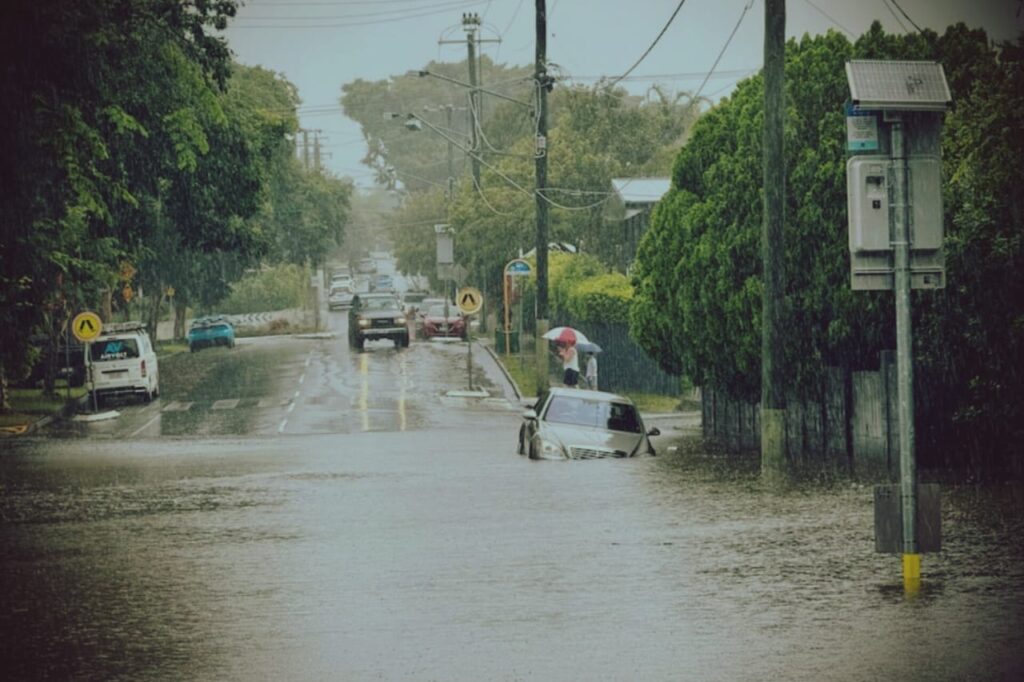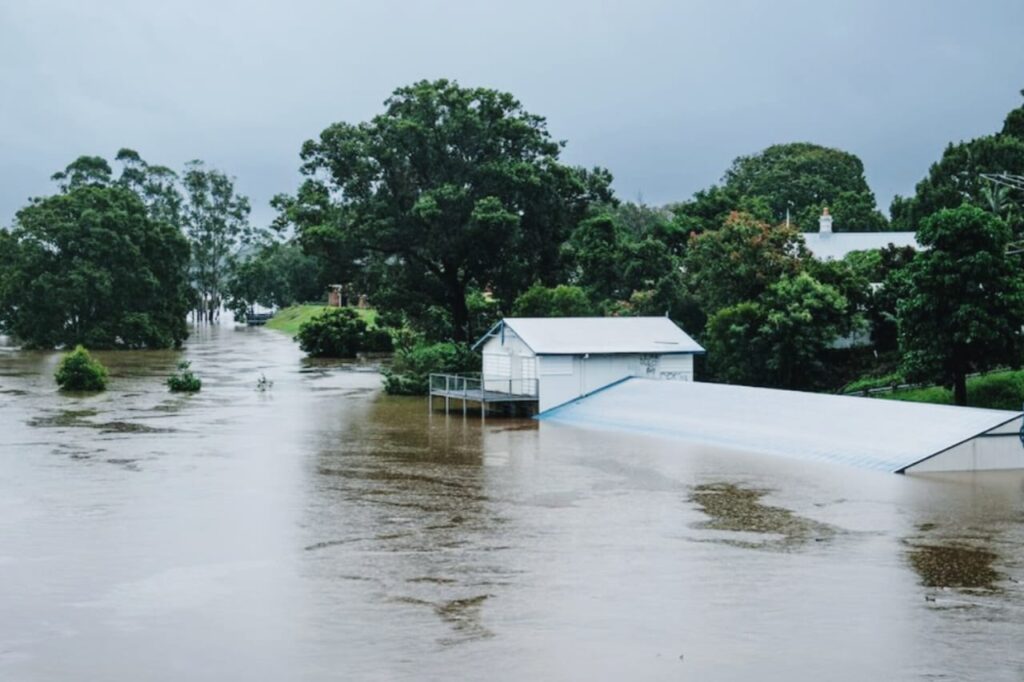Cyclone Alfred : Tropical Low Triggers Flood Emergencies Across Queensland and NSW
Australia’s eastern coast remains on high alert as ex-Tropical Cyclone Alfred continues to unleash torrential rains and destructive winds, despite being downgraded to a tropical low. With over 300,000 homes without power and flood risks escalating, Queensland and New South Wales (NSW) face a prolonged crisis. Here’s the latest analysis.

Current Impact
- Power Outages: Over 316,540 properties remain without electricity across Queensland and NSW. The Gold Coast is hardest hit, with 112,000 outages.
- Flood Warnings: 9 locations in Queensland (including Brisbane) and 11 in NSW are under urgent flood alerts. The Lockyer Valley town of Laidley faces imminent danger, with residents urged to evacuate.
- Casualties: One fatality reported in NSW floodwaters; 13 military personnel injured during rescue operations in Lismore.
Cyclone Alfred Downgraded to Tropical Low, Unleashing Flood Chaos Across Eastern Australia
Cyclone Alfred has weakened to a tropical low but continues to batter Queensland and New South Wales (NSW) with catastrophic flooding, power outages, and destructive winds.
Over 300,000 homes remain without electricity, with the Gold Coast hardest hit, while emergency services race to evacuate residents in Laidley and Grafton amid rising floodwaters.
The storm, which claimed one life in NSW and injured 13 military personnel during rescue operations, has triggered 20 evacuation centers and thousands of insurance claims.
Prime Minister Anthony Albanese announced a $1,000 disaster relief payment for affected adults and postponed the national election to prioritize crisis response.

Historic Storm Brings Unprecedented Risks to Populated Regions
Cyclone Alfred marks a rare threat to Australia’s densely populated east coast, becoming the first cyclone near Brisbane since 1974.
Its unusual southward formation and slow movement have amplified rainfall totals, with Brisbane recording 100mm in six hours and rivers like the Clarence in NSW nearing major flood levels.
The Bureau of Meteorology warns of ongoing “life-threatening” flash flooding, 90 km/h wind gusts, and coastal erosion, particularly on the Gold Coast, where beaches have suffered severe structural damage.
Authorities urge residents to avoid floodwaters, citing six overnight rescues, including a family of eight stranded in rising currents.
Government Response and Disaster Aid
Prime Minister Anthony Albanese announced a **1,000disasterreliefpayment∗∗foradultsand1,000disasterreliefpayment∗∗foradultsand400 for children affected by the cyclone. The national election, initially set for April, has been postponed to prioritize crisis management.
Weather Forecast and Risks
The Bureau of Meteorology (BoM) warns of “life-threatening” flash flooding due to heavy rainfall (50–100mm recorded in Brisbane). Key risks include:
- Damaging Winds: Gusts up to 90 km/h expected in Southeast Queensland.
- Coastal Erosion: Gold Coast beaches severely damaged, with structural collapses reported.
- River Flooding: Clarence River in Grafton (NSW) nearing major flood levels.
Table of Contents

Emergency Measures and Evacuations
- Evacuation Centers: 21 centers operational in NSW, sheltering 768 residents. Laidley State High School opened as a refuge.
- Safety Alerts: NSW SES warns against driving through floodwaters after rescuing a family of eight stranded in rising waters.
Why Cyclone Alfred Is Historically Significant
- Rarity: First cyclone near Brisbane since 1974 (Cyclone Zoe).
- Unusual Movement: Slow-moving and forming farther south than typical cyclones, amplifying rainfall and damage.
Infrastructure and Recovery Challenges
- Transport Disruptions: Gold Coast public suspended; 20% of traffic lights non-operational.
- School Closures: NAPLAN tests postponed in affected areas; schools to reopen where safe.
- Insurance Claims: 3,000+ claims lodged in 48 hours for property damage.
Recovery Challenges Mount as Storm Lingers
With Alfred’ remnants expected to linger inland until midweek, recovery efforts face prolonged disruptions. Schools in unaffected areas will resume classes, but NAPLAN testing is delayed in crisis zones, while 20% of Gold Coast traffic lights remain offline.
Energy crews work to restore power to 316,540 properties, though officials warn outages could persist for days. As the nation braces for more rain, the event underscores climate-driven shifts in cyclone patterns, with experts urging coastal communities to prepare for increasingly frequent extreme weather. For real-time updates, follow NSW SES and Queensland Emergency Services advisories.

1. What is the current status of Cyclone Alfred?
Cyclone Alfred has been downgraded to a tropical low but continues to threaten Queensland and NSW with heavy rainfall, flash flooding, and damaging winds. The system is moving inland, with the Bureau of Meteorology (BoM) warning of persistent risks, including riverine flooding in 9 Queensland locations (e.g., Brisbane) and 11 NSW areas (e.g., Grafton). Over 300,000 homes remain without power, and evacuation orders are active in Laidley (Lockyer Valley).
2. What government assistance is available for affected residents?
Prime Minister Anthony Albanese announced the Australian Government Disaster Recovery Payment: a one-off payment of
∗1,000peradult∗∗and∗∗400 per child for those impacted. Affected individuals can apply through Services Australia. Additionally, evacuation centers (21 in NSW, including Laidley State High School) provide shelter, food, and emergency support.
3. Why is Cyclone Alfred considered rare and dangerous?
This storm is unusual due to its southward formation near Brisbane (last seen in 1974) and its slow movement, which amplifies rainfall totals. Warm coastal waters allowed it to linger, dumping 50–100mm of rain in 6 hours in Brisbane. The combination of flash floods, coastal erosion, and power outages in densely populated regions like the Gold Coast has heightened risks to infrastructure and safety.
4. Are schools and public services operating?
Most schools in unaffected areas will reopen, but NAPLAN testing is delayed in cyclone-hit regions. Public transport on the Gold Coast remains suspended, with 20% of traffic lights non-operational. Energy providers aim to restore power, but outages may persist for days. Check local government advisories for real-time updates.
5. How can residents stay safe during the crisis?
Avoid floodwaters: NSW SES warns against driving or walking through flooded areas.
Secure property: Move valuables to higher ground and follow evacuation orders.
Monitor alerts: Follow BoM, NSW SES, or Queensland Emergency Services for warnings.
Use generators safely: Keep them outdoors to prevent carbon monoxide poisoning.
6. What caused the military vehicle accident in Lismore?
Thirteen Australian Defence Force (ADF) personnel were injured when two military vehicles rolled in flood-affected NSW. The incident occurred during rescue operations, highlighting the hazardous conditions. All injured are expected to recover, and an investigation is underway.
7. How long will recovery take?
Full recovery could take weeks due to widespread power outages, flood damage, and debris clearance. Insurance claims have already surpassed 3,000. Residents are urged to document property damage and contact insurers promptly. For updates on disaster payments, visit Services Australia.
“Is your area affected by Cyclone Alfred? Share your experiences or safety tips in the comments below.”


